Thursday, August 8th 2019

ASUS ROG Strix Radeon RX 5700 XT OC Detailed Some More
Ahead of its launch, the press-deck of ASUS' premium custom-design Radeon RX 5700 XT graphics card, the ROG Strix RX 5700 XT OC, was leaked to the web by VideoCardz, revealing some fascinating details. Out of the box, the card ships with clock-speeds of 1770 MHz base, 1905 MHz "game clock," and 2010 MHz boost clock, which are closer to AMD's reference-design boost clocks. A software-activated "OC mode," which requires you to install the GPU Tweak software, runs the card at 1840 MHz base, 1965 MHz game clock, and 2035 MHz boost clock. The card features dual-BIOS, which have identical clock-speeds, but change the fan-behavior. Both BIOSes enable idle fan-stop, but one of them reduces fan-speeds when gaming, compared to the other, trading temperatures for noise.
The ROG Strix RX 5700 XT OC is a purely custom-design RX 5700 XT graphics card, with a custom-design PCB that's larger than AMD's reference-design, and features a 14-phase VRM (11-phase vGPU and 3-phase vMem). ASUS deployed its latest Super Alloy Power II (SAP II) component selection, consisting of chokes that don't buzz or whine; and high quality DrMOS. The card draws power from a pair of 8-pin PCIe power connectors, and features a combination of three DisplayPorts and one HDMI. The card also puts out a 4-pin/3-pin RGB/ARGB header, and two 4-pin PWM case-fan headers. The DirectCU III cooling solution features a mirror-finish base that makes contact with the GPU. ASUS claims that the card is 32 percent quieter than the reference-design, and runs 18 percent cooler. It's also 4.7 percent faster than the reference-design
Update Aug 12th: Our review of the ASUS Radeon RX 5700 XT STRIX OC is live now.More slides follow.
Source:
VideoCardz
The ROG Strix RX 5700 XT OC is a purely custom-design RX 5700 XT graphics card, with a custom-design PCB that's larger than AMD's reference-design, and features a 14-phase VRM (11-phase vGPU and 3-phase vMem). ASUS deployed its latest Super Alloy Power II (SAP II) component selection, consisting of chokes that don't buzz or whine; and high quality DrMOS. The card draws power from a pair of 8-pin PCIe power connectors, and features a combination of three DisplayPorts and one HDMI. The card also puts out a 4-pin/3-pin RGB/ARGB header, and two 4-pin PWM case-fan headers. The DirectCU III cooling solution features a mirror-finish base that makes contact with the GPU. ASUS claims that the card is 32 percent quieter than the reference-design, and runs 18 percent cooler. It's also 4.7 percent faster than the reference-design
Update Aug 12th: Our review of the ASUS Radeon RX 5700 XT STRIX OC is live now.More slides follow.


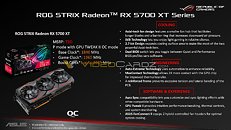


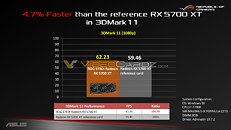



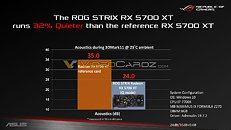
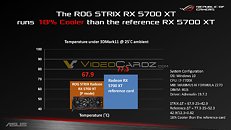


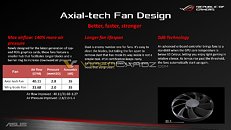

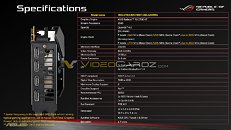
42 Comments on ASUS ROG Strix Radeon RX 5700 XT OC Detailed Some More
You really can’t please anyone these days.
“Chipset has a fan! WTFOMGBBQBLEERERUGH!”
Fan present but runs at 0% to conserve energy/lower noise levels...
OMGWTFBBQQQQWHYISTHISATHING?!??
My oh my, people...
Not keen on the Asus tweaker software lock out on the overclock.
All enabling the fans did was spread the heat out. At idle, you are still cooling the same amount of wattage.this is flat out wrong.. sorry.
This is science/physics/thermodynamics bud. All other things the same, with a higher idle, you will reach your saturation point/equilibrium faster, but it doesn't run any hotter. It makes zero sense how it would do so when the cooling properties of the cooler do not change.
That said, my point still stands. You are comparing two different cards and coolers trying to make a point... but because it is two different GPUs (I get they are both V64's, but each core is different even with the same cooler) with two different coolers you can't compare unlike things.
There could be so many reasons it wasn't cooler... but one of them WASN'T the fact that it had zero fan capabilities. :)
You can not be a fan of the zero fan functionality, but know you are moving the same amount of heat (wattage) away. enabling the fans just 'diluted' the hot spot a bit causing more turbulence in the case which allows the airFLOW to get it out.
Anyway, I digress... the take away here is that zero fan does not change the capabilities of the heatsink. It will get to its saturation point faster, but it will not have higher temps (again all other things remaining the same). It's OK to dislike it, but do so for fundamentally sound reasons.
Just because you put a CPU below a heatsink doesn't change thermodynamics/physics/science. A higher idle temps due to zero fan on idle will not change load temps!!!!!
ANyway, done here... I just wanted to correct the misinformation presented. There really isn't much of a discussion to have. You believe it (and science/how it works) or you don't. I have an open mind, but the information presented is purely anecdotal and loaded with other variables which throw off the thinking.
EDIT: It's funny watching the lemmings thank your posts...the clown car of ignorance is filling up fast!